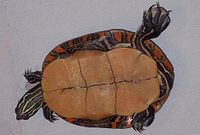| Southern painted turtle | |
|---|---|

| |
|
Scientific classification
| |
| Domain: | Eukaryota |
| Kingdom: | Animalia |
| Phylum: | Chordata |
| Class: | Reptilia |
| Order: | Testudines |
| Suborder: | Cryptodira |
| Superfamily: | Testudinoidea |
| Family: | Emydidae |
| Genus: | Chrysemys |
| Species: | C. dorsalis
|
| Binomial name | |
| Chrysemys dorsalis
Agassiz, 1857
| |
| Synonyms | |
|
Chrysemys picta dorsalis | |
The southern painted turtle (Chrysemys dorsalis) is a species of turtle in the family Emydidae. It is endemic to the south-central United States. [1]
Taxonomy
The southern painted turtle was formerly considered a subspecies of the more widespread painted turtle (C. picta) as C. picta dorsalis, and its exact status is still debated. [1]
Since the 1950s, the southern painted turtle, alongside the subspecies of C. picta, was generally thought to have originated following geographic isolation as a result of the Quaternary glaciation, with the populations being isolated for too short a time to fully diverge into distinct species. [2] However, David E. Starkey and collaborators advanced a new view of the subspecies in 2003. Based on a study of the mitochondrial DNA, they rejected the glacial development theory and argued that the southern painted turtle should be elevated to a separate species, C. dorsalis, while the other subspecies should be collapsed into one and not differentiated. [3] However, this proposition was largely unrecognized because successful breeding between all subspecies was documented wherever they overlapped. [4] [5] Nevertheless, in 2010, the IUCN recognized both C. dorsalis and C. p. dorsalis as valid names for the southern painted turtle. [6] [7] In 2014, the Turtle Taxonomy Working Group (TTWG) and the Reptile Database reclassified C. dorsalis as a distinct species, although the TTWG also recognized C. p. dorsalis as a valid name. The TTWG continued to recognize C. dorsalis as a distinct species in their 2021 publication. [7]
Description

The smallest member of Chrysemys, it is smaller than any of the subspecies of C. picta at about 10–14 cm (4–6 in) long. [8] Its top stripe is a prominent red, [9] and its bottom shell is tan and spotless or nearly so. [10]
Ecology
This species' diet changes with age. Juveniles' diet consists of 13% vegetation, while the adults eat 88% vegetation. This perhaps shows that the turtle prefers small larvae and other prey, but can only obtain significant amounts while young. [11] The reversal of feeding habits with age has also been seen in the false map turtle, which inhabits some of the same range. The most common plants eaten by adult southern painted turtles are duckweed and algae, and the most common prey items are dragonfly larvae and crayfish. [12]
Distribution
The southern painted turtle ranges from extreme southern Illinois and Missouri, roughly along the Mississippi River Valley, to the south. In Arkansas, it branches out to the west towards Texas, where it is found in the far northeast part of that state ( Caddo Lake region) [13] as well as extreme southeastern Oklahoma ( McCurtain County). [14] It is found in much of Louisiana, where it reaches the Gulf of Mexico (in fresh water). Eastward it is found in western Tennessee, northern Mississippi and much of Alabama, including the Gulf Coast city of Mobile. [15] [16] An isolated population in central Texas has been reported but is now believed to be non-native. [17]
Life history
It has a smaller clutch size than C. picta, at about 4.2 eggs per clutch. [18]
References
- ^ a b "Chrysemys dorsalis". The Reptile Database. Retrieved 2022-03-28.
- ^ Ernst & Lovich 2009, p. 187.
- ^ Starkey, David; Shaffer, H. Bradley; Burke, Russel; Forstner, Michael R. J.; et al. (2003). "Molecular systematics, phylogeography, and the effects of pleistocene glaciation in the painted turtle (Chrysemys picta) complex". Evolution. 57 (1): 119–128. doi: 10.1111/j.0014-3820.2003.tb00220.x. PMID 12643572. S2CID 16681228.
- ^ Fritz & Havaš 2007, p. 177.
- ^ Mann 2007, p. 2.
- ^ Rhodin et al. 2010, p. 000.99.
- ^ a b Rhodin, Anders G.J. (2021-11-15). Turtles of the World: Annotated Checklist and Atlas of Taxonomy, Synonymy, Distribution, and Conservation Status (9th Ed.). Chelonian Research Monographs. Vol. 8. Chelonian Research Foundation and Turtle Conservancy. doi: 10.3854/crm.8.checklist.atlas.v9.2021. ISBN 978-0-9910368-3-7. S2CID 244279960.
- ^ Carr 1952, p. 226.
- ^ Senneke, Darrell (2003). "Differentiating painted turtles (Chrysemys picta ssp)". World Chelonian Trust. Retrieved 2010-12-09.
- ^ Ernst & Lovich 2009, p. 186.
- ^ Carr 1952, p. 228.
- ^ Carr 1952, pp. 227–228.
- ^ Dixon, James Ray (2000). "painted+turtle"&pg=PA196 Amphibians and reptiles of Texas. Texas A&M University Press. p. 196. ISBN 978-0-89096-920-5. Retrieved 2011-01-14.
- ^ "Species of turtles in OK". Oklahoma Department of Wildlife Conservation. Archived from the original on 2011-05-25. Retrieved 2011-07-21.
- ^ Ernst & Lovich 2009, p. 185.
- ^ Conant, Roger; Collins, Joseph T. (1998). Field guide to reptiles and amphibians of eastern and central North America. New York: Houghton Mifflin Harc. pp. 185–186. ISBN 978-0-395-90452-7.
- ^ McAllister, Chris T.; Forstner, Michael R.J.; Fuller, Jonathan P. (2007-05-01). "Second report of the southern painted turtle, Chrysemys dorsalis (testudines: emydidae), from Texas, with comments on its genetic relationship to other populations". The Texas Journal of Science. 59 (2).
- ^ Ernst & Lovich 2009, p. 201.